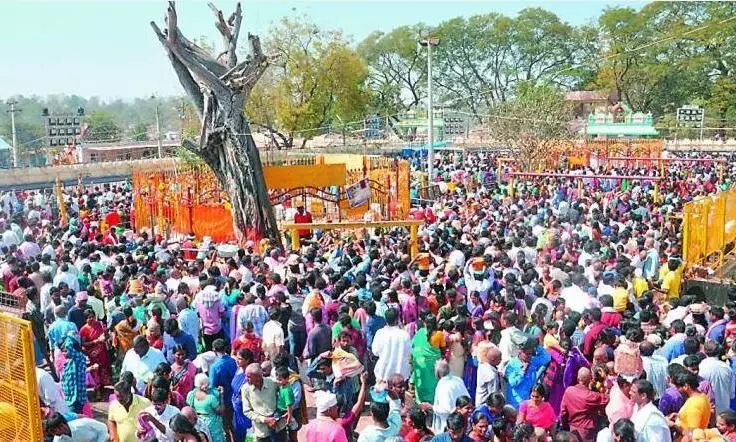Medaram Jatara: World's largest tribal congregation to start from February 21, Aadhar must for jaggery
The biannual four-day Sammakka Sarakka Jatara considered the world’s largest tribal religious congregation attracting several millions, will begin on February 21 at Medaram in Tadvai mandal of Mulugu district.

WARANGAL: The biannual four-day Sammakka Sarakka Jatara, considered the world’s largest tribal religious congregation attracting several millions, will begin on February 21 at Medaram in Tadvai mandal of Mulugu district. This festival was declared a State Festival in 1998.
While the population of the little forest village at Medaram is about 300, over 1.2 crore devotees visit the festival during the four-day festival. Devotees from Telangana, Andhra Pradesh, and neighbouring states like Odisha, Karnataka, Maharashtra, and Madhya Pradesh throng the tribal festival.
Sammakka Sarakka Jatara
Sammakka Saralamma or Sammakka Sarakka Jatara also known as Medaram Jatara is a tribal festival honouring the goddesses. It commemorates the fight of a mother and daughter, Sammakka and Saralamma, with the reigning rulers against their unjust law. It is believed that after the Kumbha Mela, the Medaram Jatara attracts the largest number of devotees in the country.
It is celebrated in Medaram during the time the goddesses of the tribals are believed to visit them. Medaram is a remote place in the Eturnagaram Wildlife Sanctuary, a part of Dandakaranya, the largest surviving forest belt in Mulugu.
The legend says that about 6-7 centuries ago, that is in the 13th century, some tribal leaders who went hunting found a newborn girl (Sammakka) emitting enormous light playing amidst tigers. She was taken to their habitation.
The head of the tribe adopted her and was brought up as a chieftain. She was married to Pagididda Raju a tribal chief of Kakatiyas. She was blessed with two daughters and one son namely Sarakka, Nagulamma, and Jampanna respectively.
The ritual
The fair gets underway with the customary arrival of Sarakka's image from Kannepally village which was placed on a platform in Medaram. The image idol covered in red cloth was brought in a vessel laden with vermillion and turmeric powder. The unique rituals began as the tribal priests huddled into a small temple at Kannepally located four kilometres away from Medaram. They offer prayers for hours invoking goddess onto them before coming out of the temple. The deity was accorded traditional honours by a group of tribal priests and district officials.
Devotees offer Bangaram (jaggery) of a quantity equal to their weight to the goddesses and take holy baths in Jampanna vagu. It is a purely tribal festival with no vedic or brahmanical influence.
Jampanna Vagu
Jampanna vagu is a tributary to River Godavari. According to legend, Jampanna was the tribal warrior and the son of the tribal goddess Sammakka. The Jampanna vagu took his name as he died in a battle fighting against the Kakatiya army in that stream.
The Jampanna vagu is still red and devotees believe that it is red with the blood of Jampanna. Tribals believe that taking a holy dip in the red water of Jampanna vagu reminds them of the sacrifice of their gods who saved them and also induces courage into their souls. There is a bridge constructed on top of Jampanna Vagu, known as Jampanna Vagu Bridge.
TSRTC to run 6,000 buses
This year the TSRTC will run 6,000 special buses to and from jatara to carry 30 lakh passengers. These buses will be operated from 51 points across the State from February 18 to 24. Recently state Ministers Ponnam Prabhakar and Seetakka visited ticket counters at Tadvai and reviewed the preparations. TSRTC also declared that the ongoing free bus service for women will apply for special buses to jatara.
No environmental impact tax
All vehicles passing through Eturu Nagaram reserve forest touching Sammakka Sarakka Jatara (Medaram Jatara) from February 2 to 29 are exempted from paying the environmental impact fee. As per the orders issued by the chief wildlife warden, this would facilitate the free flow of traffic and also help devotees from shelling down extra money to reach Medaram Jatara.
The Forest Department had been collecting a nominal fee from vehicles entering from the Pasra, Tadvai, and Eturu Nagaram areas. The collected amount was put to use to protect the reserve forest and wildlife and also to collect plastic and other waste that could endanger the wildlife. However, devotees had been requesting the State Government to exempt the vehicles from paying the fee during the Jatara.
Aadhar must for jaggery
To restrict the misuse of jaggery which is offered to the goddesses as ‘bangaram” by the devotees the Government decided to implement the Aadhar rule this time. Devotees who wish to offer jaggery have to submit a Xerox copy of their Aadhar at the counters. The excise department made it clear that the devotees must furnish their name, phone number, and the purpose of purchasing the jaggery. Excise staff will have to compile the data and submit it to district-level officials daily.
Online payment for jaggery
The Minister for Forest, Environment, and Endowments Konda Surekha launched an online facility for payment for those who can not travel to Medaram during the Jatara or afterwards. Devotees offer jaggery equivalent to their body weight as a thanks giving to the deities. One can pay the amount based on their body weight through Mee Seva, TApp, and 1.5 lakh outlets of the Postal Department.
Maoists demand tribal customs
In an open letter Venkatesh, secretary of the Jayashankar, Mulugu, Warangal, and Peddapally (JMWP) Division Committee of the CPI-Maoist, has demanded the State Government to make arrangements in full accordance with tribal customs for the jatara.
Maoists warned against distributing anything other than jaggery called banagaram such as laddu or pulihora, to devotees as prasadam at Medaram.
Maoists demanded the maintenance of the forest area to keep up cleanliness to maintain hygiene and compensate the farmers who left their crops fallow for the conduct of the Jatara.



